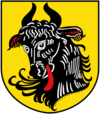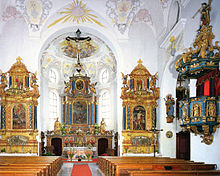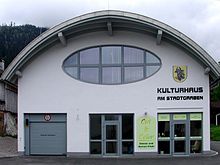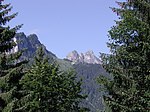Vils (city)
|
Borough Vils
|
||
|---|---|---|
| coat of arms | Austria map | |
|
|
||
| Basic data | ||
| Country: | Austria | |
| State : | Tyrol | |
| Political District : | Reutte | |
| License plate : | RE | |
| Surface: | 30.77 km² | |
| Coordinates : | 47 ° 33 ' N , 10 ° 38' E | |
| Height : | 826 m above sea level A. | |
| Residents : | 1,492 (Jan 1, 2020) | |
| Postal code : | 6682 | |
| Area code : | 05677 | |
| Community code : | 7 08 33 | |
| NUTS region | AT331 | |
| Address of the municipal administration: |
Town square 1 6682 Vils |
|
| Website: | ||
| politics | ||
| Mayor : | Manfred Immler (List of the Vilser People's Party) | |
|
Municipal Council : (2016) (13 members) |
||
| Location of Vils in the Reutte district | ||
 View from the south with the castles Vilsegg (right) and Falkenstein (Bavaria, left) |
||
| Source: Municipal data from Statistics Austria | ||
Vils is a town in the Reutte district in Tyrol ( Austria ) with 1,492 inhabitants (as of January 1, 2020). Vils is one of the smallest towns in Austria and the only one in the Reutte district.
geography
Vils is located between Tannheimer Bergen and Falkensteinkamm on the border with Bavaria in the valley of the river Vils of the same name . The Vils comes from the neighboring Bavarian municipality of Pfronten and soon flows below the city into the Lech , which flows through a short gorge (see Lechfall ) into Füssen in Bavaria . The other neighboring communities of Vils are in Austria: Grän in the Tannheimer Mountains and Musau and Pinswang in the Lech Valley.
Population development

history

The town charter was already Vils 1327 by King Louis IV. (1328 German-Roman Emperor) under the laws of Kaufbeuren awarded. The center is characterized today by wide houses with gabled roofs and facade paintings ( agricultural town ). Agriculture was the most important source of income until the 20th century. The Lords of Hohenegg, influential noblemen in the Middle Ages, expanded Vilsegg Castle , which is now in ruins.
In 1408, Duke Friedrich IV of Austria-Tyrol (Friedel with the empty pocket) took over the fiefdom of Vilsegg from the Kempten monastery , but still enfeoffed the Lords of Hohenegg with the rule of Vils. After the death of the last Hohenegger in 1671, Vils came to Austria, but not to Tyrol.
After the lost war against Napoleon, Austria had to cede Tyrol, its Swabian possessions and Vils to Bavaria in 1805. It was not until 1816 that Vils finally fell to Austria / Tyrol in exchange for the formerly Austrian-Bohemian Marktredwitz due to the negotiations at the Congress of Vienna . In 2016 Vils celebrated two hundred years of belonging to Tyrol.
On April 28, 1945 the US Army crossed the border to Austria between Pfronten and Vils.
City arms
The original coat of arms shows a black ox or bull head with a red tongue on a yellow (golden) background from the front side, which is refreshed with water (from the Vils ). In the new city coat of arms, which has been official for around a hundred years, an ox or bull head with a red tongue on a yellow (gold) background is depicted from the side without water. It is based on the coat of arms of the Lords of Hohenegg . The colors of the flag are black and yellow (gold).
Culture and sights
Buildings
- City parish church: The city parish church of the Assumption of Mary was built on the site of the dilapidated church until 1709 in Baroque style and inaugurated in 1723 by the Augsburg bishop. The St. Catherine chapel is attached to the church. Inside the church is light, high and spacious and decorated with stucco work. A large crucifix hangs on the choir arch. The pneumatic organ from 1728 was largely replaced by a mechanical organ in 1995. There are five bells in the tower. The largest bell was cast by Peter and Georg Löffler in 1524. The Grassmayr bell foundry in Innsbruck cast three more bells . During the church year, the high altar is given a festive dress several times - Lenten nativity scene, May tarry, Sacred Heart altar and Christmas nativity scene. With the four baroque altars and the choir stalls, the parish church offers the observer a unity that only a pure baroque building can exude.
- Sankt-Anna-Kirchlein: To the north-west of the city and on the other side of the Vils, at the foot of the ruins of Vilsegg, are a hammer forge and the Sankt-Anna-Kirchlein. It was built in Romanesque style in the thirteenth century at the latest and served the Lords of Hohenegg as a castle church. The main building of the church is Gothic vaulted and equipped with Gothic choir stalls and three Baroque altars.
- Barbara Chapel: is located on the Schretter company premises. It was built in 1999 for the company's 100th anniversary
- Museum of the city of Vils : In the museum of the city of Vils , which has found a place to stay in the old office building (Schlössle), violins, mainly from the Rief family, are shown alongside objects from the past. A geology room provides information about the rock deposits around Vils. In addition, the sponsor of the museum, the VilsArt Kulturverein, publishes a cultural guide every year.
- Kulturhaus: With the opening of the Kulturhaus in 2008, some of the more than 20 associations have found a new home. The registry office and the meeting room of the municipal council are also located in this house.
Excursion destinations
These destinations can be reached either directly from Vils or after a short drive: Falkenstein Castle , where King Ludwig II wanted to build another castle, the romantic fairytale castle Neuschwanstein Castle , Hohenschwangau Castle , the legendary Alatsee , which in summer Bathing invites, the treetop path with forest adventure center on the border towards Füssen , the district of Sankt Anna with hammer mill, church and castle ruins Vilsegg , the Salober-Alm and the Vilser Alm .
Regular events
- Spring concert: the town band organizes a spring concert every year.
- Fire brigade festival: Every year in May at the Vils fire brigade square.
- Parish festival: beginning of July (1st concert).
- 4 square concerts: Every Tuesday in July, the parish festival is also the 1st square concert.
- Stadtrock: Organized by the Krampus Association in July
- City festival: on August 15th (Feast of the Assumption of the Virgin Mary) the town band organizes an atmospheric town festival in Stadtgasse.
- Theater performance: Every year around Christmas time, an amateur play group performs a comedy.
- Christmas cribs : From Christmas to Candlemas, valuable Christmas cribs are set up in many houses.
- Processions: On Corpus Christi day , on Sacred Heart Sunday and on Kirchweihtag (Assumption Day), solemn processions are held annually .
Economy and Infrastructure
Companies
With the foundation of the Schretter & Cie cement works in 1899, Vils became an industrial site. The raw materials limestone and marl are mined in the limestone quarries to the south and after processing are transported by truck or by the Ausserfernbahn, which is also used for passenger transport. There is a lime plant and a mixing plant at the company site. The company also has a gypsum plant in Weißenbach am Lech and a cement grinding and shipping facility in Kirchbichl .
A Bavarian entrepreneur runs Metalltechnik Vils GesmbH to the west of Vils. In the village and in the Stegen business park, there are restaurants, trade and craft businesses.
Since 2013, the “Vilser Bergbräu” has been continuing the brewing tradition in Vils, which previously existed until 1900. A show brewery was set up in the newly built premises in 2016.
education
The educational institutions have a kindergarten, a primary school, a new middle school, an adult school and the Genuss-Akademie.tirol.
traffic
The station building, which is located in the eastern area of Vils, was closed on September 14, 2016. The adapted station area only serves the not inconsiderable rail freight traffic. The Vils Stadt passenger transport station, which is centrally located northeast of the parish church and opened in December 2016, now exists on the Ausserfernbahn . This route connects Kempten (Allgäu) with Reutte and continues to Garmisch-Partenkirchen . There is a connection via the Mittenwaldbahn towards Innsbruck or via the Werdenfelserlandbahn to Munich . Reutte and Füssen in the Allgäu can also be reached by public bus transport.
Vils is on the long-distance cycle path , which runs as the Via Claudia Augusta along an ancient Roman road of the same name .
Town twinning
- Marktredwitz in Bavaria - see history , area swap 1816 between Bavaria and Austria.
sons and daughters of the town
- Rudolf von Hohenegg, knight, administrator of the Kempten monastery, later Chancellor and Archbishop of Salzburg
- Peter von Hohenegg, knight, good relationship with King Ludwig IV of Bavaria, town status 1327.
- Balthasar Springer or Balthasar Sprenger , seafarer, oldest travelogue
- Josef Benedikt Freiherr von Rost, Prince-Bishop of Chur and founder of the Vils School 1696–1754
- Johann Ulrich Eberle , violin maker 1699–1768 Prague
- Johann Conrad Wörle, organ builder 1701–1777 Rome
- Franz (II.) Petz, violin maker 1702–1772
- Balthasar Riepp , important painter 1703–1764 Vils
- Dominikus Rief, violin maker 1759–1814
- Georg Geisenhof , church historian and writer 1780–1861
- Georg Schretter, founder of Schretter & Cie 1861–1924
- Otto Keller , farmer and politician 1926–2018
Others
Vils has the longest span of an overhead line in Austria, at 732 meters.
Web links
Individual evidence
- ^ Online presence of the history of Tyrol : City of Vils
























